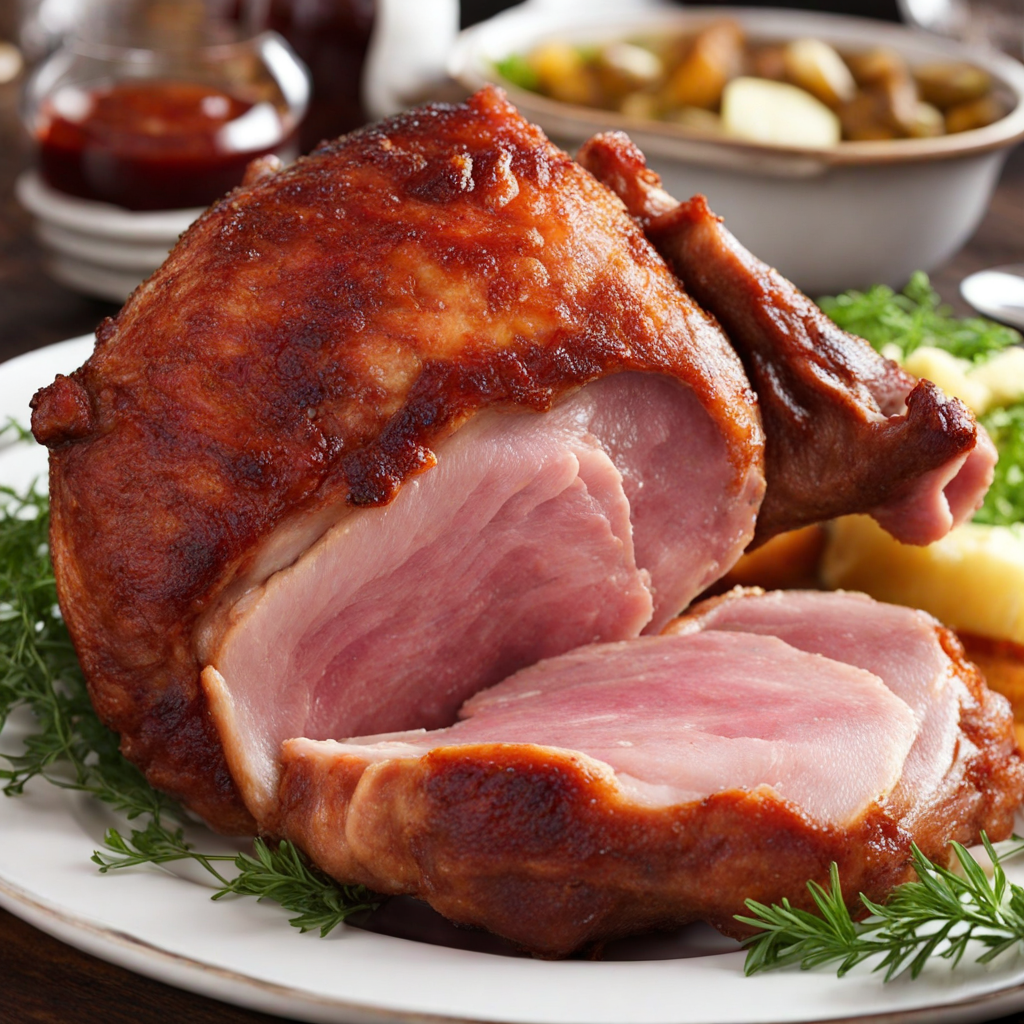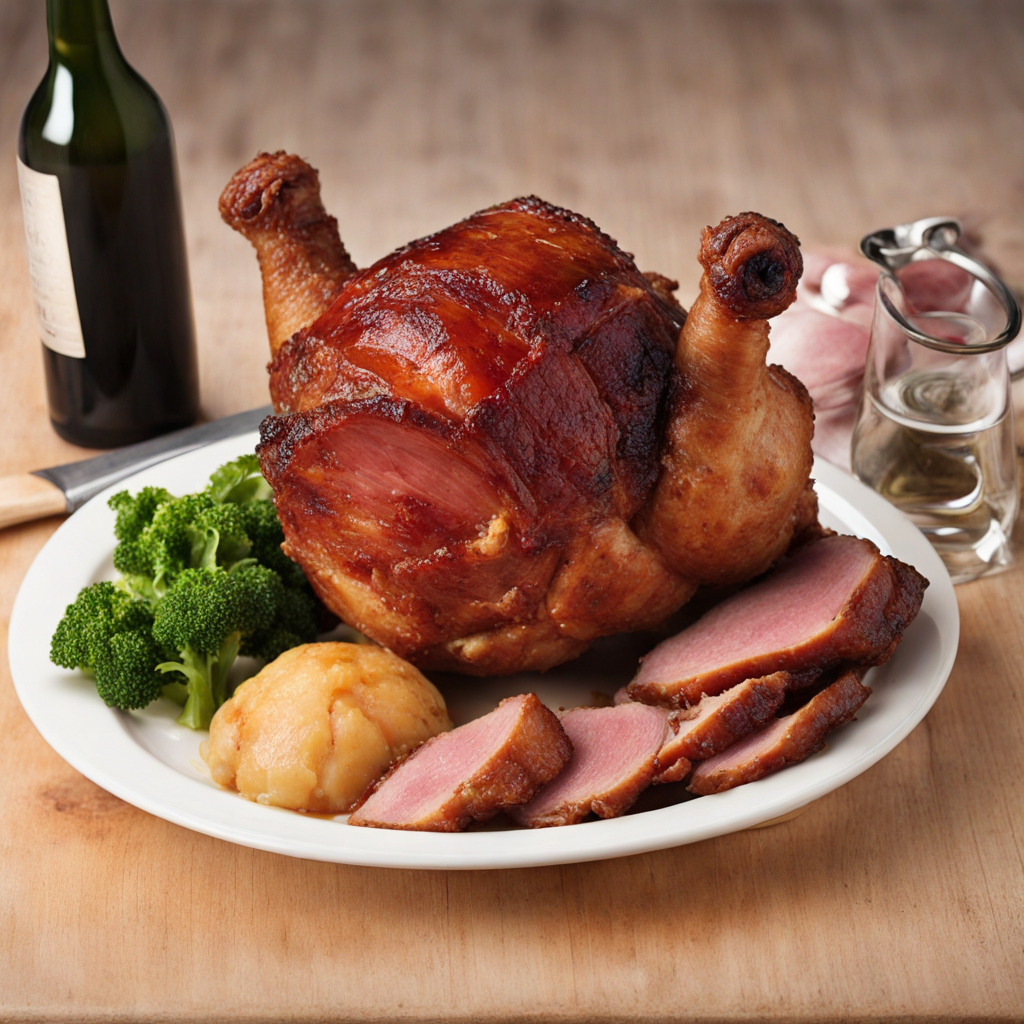Pork Knuckle
Pork Knuckle, known as "Schweinshaxe" in Germany, is a hearty dish that embodies the rustic charm of German cuisine. This succulent cut of meat, typically taken from the hind leg of the pig, is renowned for its rich flavors and tender texture. The skin is often roasted to a crispy perfection, creating a delightful contrast to the juicy, flavorful meat beneath. The preparation usually involves marinating the knuckle with a blend of spices, herbs, and sometimes beer, allowing the flavors to permeate the meat. The result is a dish that is both savory and aromatic, making it a beloved choice among locals and visitors alike.
How It Became This Dish
The History of Schweinshaxe: A Culinary Icon of Germany Schweinshaxe, the succulent and crispy pork knuckle, is a beloved dish that embodies the heart and soul of German cuisine. Its roots run deep in the cultural and historical tapestry of Germany, reflecting the agricultural practices, regional variations, and culinary traditions that have shaped the nation’s palate over centuries. This exploration into the history of Schweinshaxe will illuminate its origins, cultural significance, and the evolution of this iconic dish. #### Origins: A Dish Born of Necessity The origins of Schweinshaxe can be traced back to the medieval period in Europe when food was often dictated by availability and necessity. In rural Germany, the pig was a staple animal on farms, valued for its ability to provide sustenance to families throughout the year. Every part of the pig was utilized, from the meat to the skin to the internal organs, ensuring that nothing went to waste. The knuckle, or haxe, being a tougher cut, was often slow-cooked or roasted to tenderize it. The traditional preparation of Schweinshaxe likely emerged from the need to preserve meat before modern refrigeration techniques were developed. In many German households, particularly in Bavaria and other southern regions, the knuckles were cured or seasoned with salt and spices and then cooked in a way that would enhance their flavor while also preserving them. The use of beer for braising is a common practice, as it not only tenderizes the meat but also infuses it with rich, complex flavors. #### Cultural Significance: A Symbol of Tradition Schweinshaxe is more than just food; it is a symbol of German culture and tradition. The dish is particularly emblematic of Bavarian cuisine, where it is often served in beer gardens and during festivals. The connection between Schweinshaxe and beer cannot be overstated, as the dish is frequently paired with local brews, especially during Oktoberfest, the world-renowned festival celebrating beer and Bavarian culture. During Oktoberfest, Schweinshaxe is a cornerstone of the culinary offerings, attracting visitors from around the globe. The sight of golden-brown, crispy knuckles served with a hearty side of sauerkraut and dumplings is a quintessential image of German festivity. This pairing highlights the regional ingredients and culinary practices that are central to Bavarian identity. In addition to its presence in beer gardens and festivals, Schweinshaxe is often featured in family gatherings and celebrations, symbolizing comfort and togetherness. The preparation of this dish is often a communal event, with family members coming together to share in the cooking process, fostering a sense of connection and tradition. #### Development Over Time: From Rustic Dish to Gourmet Delight As Germany evolved through the centuries, so too did the preparation and presentation of Schweinshaxe. In the early days, it was a rustic dish meant to feed families and communities. However, as culinary techniques advanced and the dining landscape changed, Schweinshaxe began to take on new forms. In the 19th century, with the rise of the middle class and the establishment of restaurants, Schweinshaxe became a dish that could be enjoyed not just at home but also in public establishments. The emphasis on presentation and the culinary arts began to transform how Schweinshaxe was served. Chefs started to refine cooking methods, focusing on achieving the perfect balance of crispy skin and tender meat. The advent of modern cooking technology, such as convection ovens and pressure cookers, has also influenced the preparation of Schweinshaxe. Today, chefs experiment with different marinades and cooking techniques, including smoking and sous-vide, to create new interpretations of this traditional dish while still honoring its rustic roots. Regional variations of Schweinshaxe have also emerged over time. In Franconia, for instance, the dish is often served with a darker beer gravy, while in other regions, it may be accompanied by a lighter sauce. The inclusion of sides like potato salad, red cabbage, or even spätzle further illustrates the versatility of Schweinshaxe across Germany. #### Schweinshaxe in Contemporary Cuisine In recent years, Schweinshaxe has made a significant impact on global cuisine, appearing on menus far beyond Germany’s borders. As culinary enthusiasts and travelers have sought to explore authentic German dishes, Schweinshaxe has gained recognition for its bold flavors and hearty nature. Chefs around the world have embraced this dish, often adding their own twists, such as fusion with Asian flavors or incorporating international spices. The rise of the craft beer movement has also bolstered the popularity of Schweinshaxe, as many craft breweries are now pairing their brews with this traditional dish. This synergy not only celebrates the flavors of both the beer and the pork but also keeps the cultural significance of Schweinshaxe alive in a modern context. Furthermore, the increasing interest in slow-cooking techniques and comfort foods has led to a resurgence of traditional dishes like Schweinshaxe in home kitchens. Food blogs, cooking shows, and social media platforms have contributed to the revival of interest in preparing this dish. Home cooks share their methods, tips, and personal stories about Schweinshaxe, thus weaving it into the fabric of contemporary culinary culture. #### Conclusion: A Legacy of Flavor and Tradition The journey of Schweinshaxe from its humble beginnings as a peasant’s dish to a global culinary phenomenon is a testament to the resilience and adaptability of traditional food. It reflects the essence of German culture, where culinary practices are intertwined with history, community, and celebration. As Schweinshaxe continues to evolve, it retains its connection to the past while embracing new influences and interpretations. In every crispy bite of Schweinshaxe, one can taste not only the savory flavors of perfectly roasted pork but also the rich history of a dish that has transcended generations. Whether enjoyed at a bustling beer garden during Oktoberfest or prepared lovingly in a family kitchen, Schweinshaxe remains a cherished symbol of Germany’s culinary heritage, inviting all to partake in its delicious legacy.
You may like
Discover local flavors from Germany







